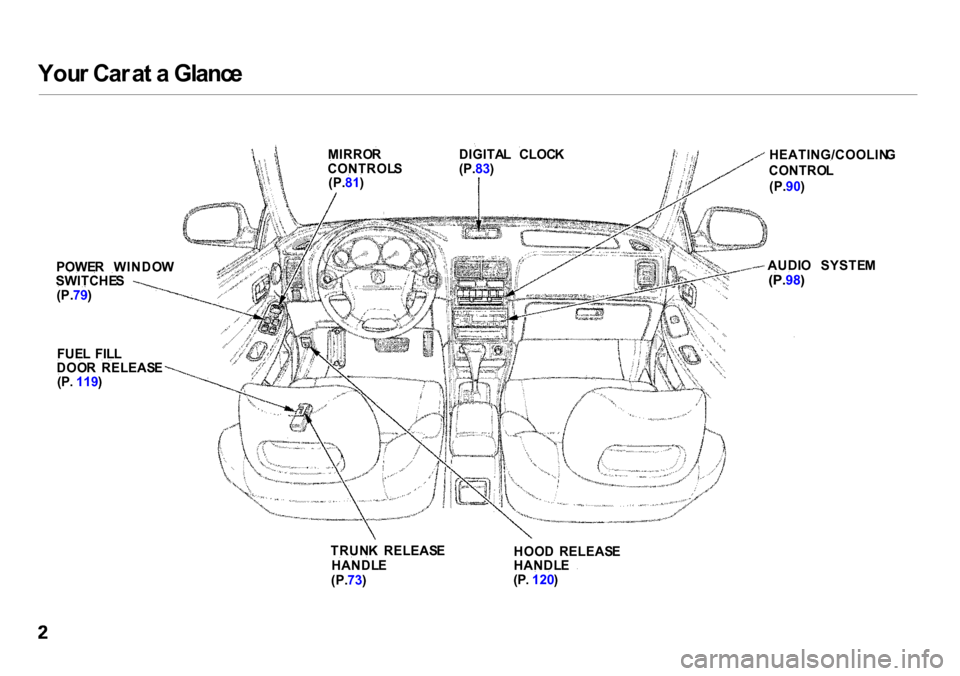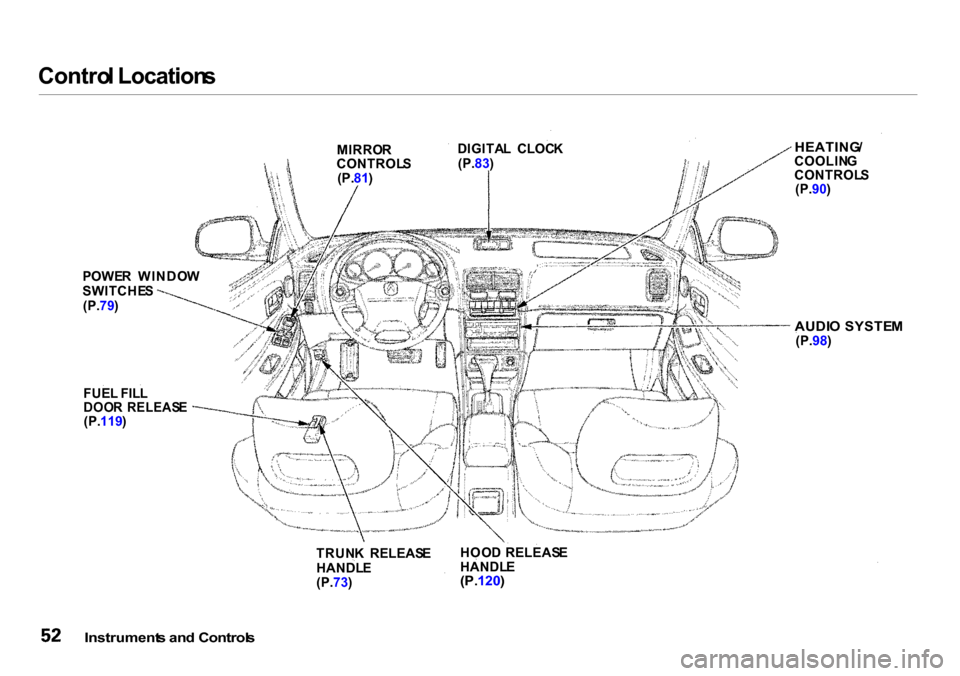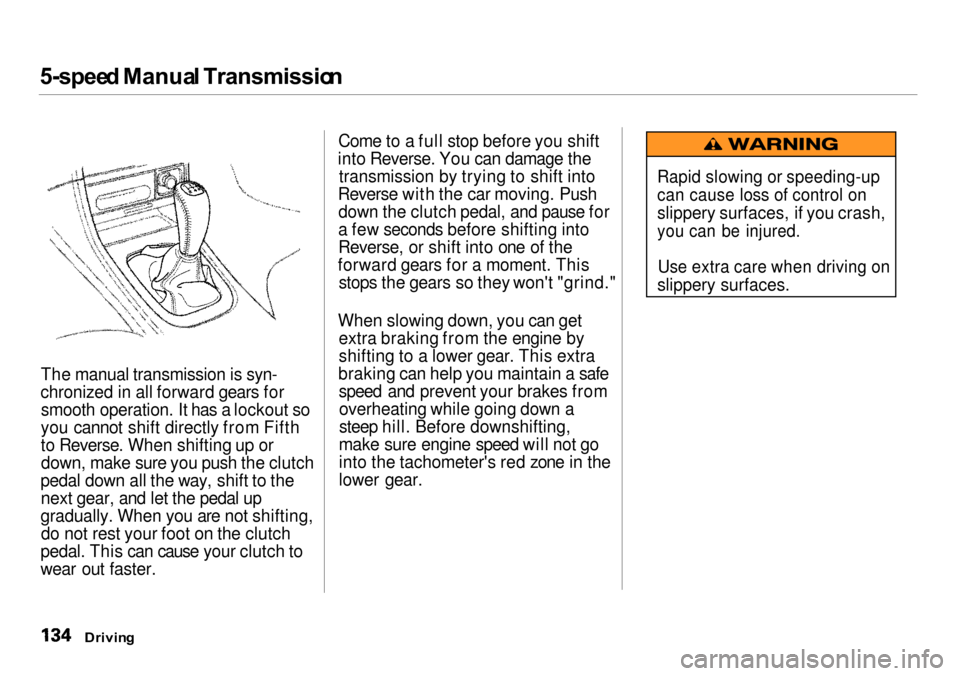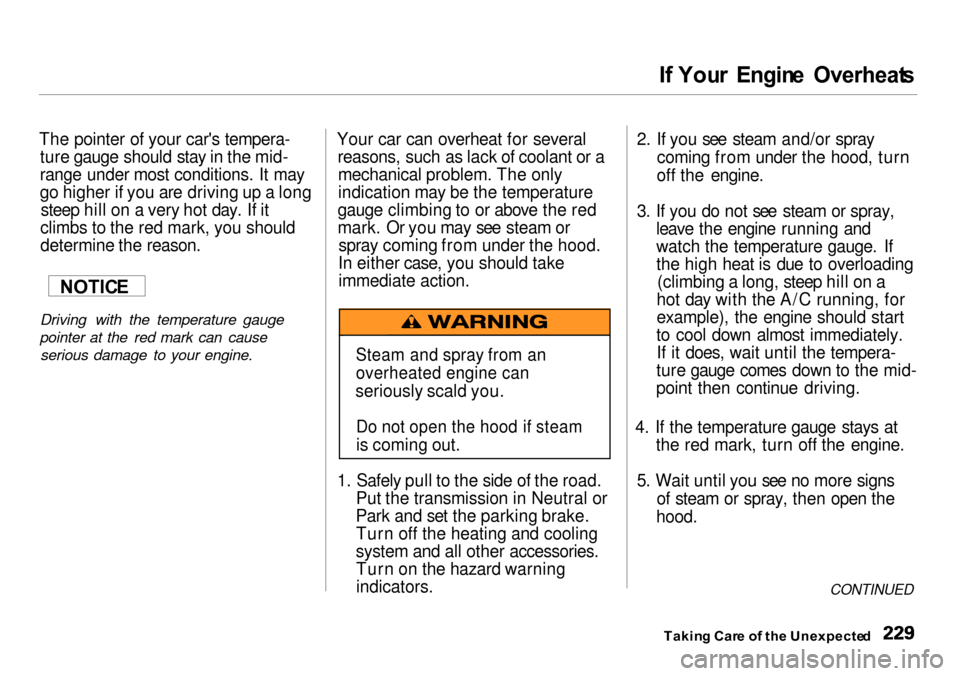heating Acura Integra 2000 Sedan Owner's Manual
[x] Cancel search | Manufacturer: ACURA, Model Year: 2000, Model line: Integra, Model: Acura Integra 2000Pages: 273, PDF Size: 4.4 MB
Page 5 of 273

You
r Car a t a Glanc e
MIRROR
CONTROL S
(P. 81) DIGITA
L CLOC K
(P. 83) HEATING/COOLIN
G
CONTRO L
(P. 90)
POWE R WINDO W
SWITCHE S
(P. 79) AUDI
O SYSTE M
(P. 98)
FUE L FIL L
DOO R RELEAS E
(P .
119 )
TRUNK RELEAS E
HANDL E
(P. 73) HOO
D RELEAS E
HANDL E
(P .
120 )
Page 52 of 273

Carbo
n Monoxid e Hazar d
Your car's exhaust contains carbon monoxide gas. You should have no
problem with carbon monoxide
entering the car in normal driving if
you maintain your car properly.
Have the exhaust system inspected
for leaks whenever: The car is raised for an oil change.
You notice a change in the sound
of the exhaust.
The car was in an accident that
may have damaged the underside.
High levels of carbon monoxide can
collect rapidly in enclosed areas, such a
s a garage. Do not run the
engine with the garage door closed.
Even with the door open, run the
engine only long enough to move the
vehicle out of the garage. With the trunk lid open, air flow can
pull exhaust gas into your car's
interior and create a hazardous
condition. If you must drive with the
trunk lid open, open all the windows
and set the climate control system as
shown below.
If you must sit in your parked car,
even in an unconfined area, with the
engine running, adjust the heating
and cooling system as follows: 1. Select the Fresh Air mode. 2. Select the mode.
3. Turn the fan on high speed.
4. Set the temperature control to a comfortable setting.
Drive r an d Passenge r Safet y
Carbon monoxide gas is toxic.
Breathing it can cause
unconsciousness and even kill
you.
Avoid any enclosed areas or
activities that expose you to
carbon monoxide.
Page 55 of 273

Contro
l Location s
Instrument s an d Control s
HOO
D RELEAS E
HANDL E
(P. 120 )
TRUN
K RELEAS E
HANDL E
(P. 73)
FUE
L FIL L
DOO R RELEAS E
(P. 119 )
POWE
R WINDO W
SWITCHE S
(P. 79)
AUDIO SYSTE M
(P. 98)
HEATING
/
COOLIN G
CONTROL S
(P. 90)
DIGITA
L CLOC K
(P. 83)
MIRRO
R
CONTROL S
(P. 81)
Page 88 of 273

Consol
e Compartment , Cigarett e Lighte r
Consol e Compartmen t
To open the console compartment, pull up the front edge of the lid.
To close, lower the lid and push it down until it latches. The pocket on the underside of the
console compartment lid can be used
to hold cards. Cigarett
e Lighte r
The ignition switch must be in
ACCESSORY (I) or ON (II) for the
cigarette lighter to work. To heat up
the lighter, push it in. It will pop out
when it is ready for use. Do not hold
the lighter in while it is heating up,
you could cause it to overheat.
Instrument s an d Control s
CIGARETT
E LIGHTE R
CAR
D HOLDE R
CONSOL E COMPARTMEN T
Page 92 of 273

Comfor
t an d Convenienc e Feature s
The heating and air conditioning systems in your Acura provide a com-
fortable driving environment in all
weather conditions.
The standard audio system has
many features. This section de-
scribes those features and how to
use them. (If you selected an
optional audio system, refer to the
operating instructions that came
with it.)
Your Acura has an anti-theft audio system that requires a code number
to enable it.Heating and
Cooling..................... 90
What Each Control Does............ 90
How to Use the System............... 92
To Turn Everything Off............. 97
Audio System................................... 98
Operating the Radio.................... 99
Adjusting the Sound.................. 102 Radio Frequencies..................... 103
Radio Reception......................... 103 Operating the CD Player.......... 105
Operating the Optional CD Changer.................................. 107
Protecting Compact Discs........ 108
CD Player Error Indications..... 109
CD Changer Error Indications.............................. 110
Operating the Optional Cassette Player...................... 111
Tape Search Functions............. 112
Caring for the Cassette Player...................................... 114
Theft Protection............................. 115
Comfor t an d Convenienc e Feature s
Page 93 of 273

Heatin
g an d Coolin g
Proper use of the Heating and
Cooling system can make the
interior dry and comfortable, and
keep the windows clear for best
visibility.
Wha t Eac h Contro l Doe s
Fa n Contro l Leve r
Sliding this lever to the right
increases the fan's speed, which
increases air flow.
Temperature Contro l Leve r
Sliding this lever to the right
increases the temperature of the air
flow.
Ai r Conditionin g (A/C ) Butto n
This button turns the air condi-
tioning ON and OFF. The indicator
in the button lights when the A/C is
on.
Recirculatio
n Butto n
This button controls the source of
the air going into the system. When
the indicator in this button is lit, air
from the car's interior is sent through the system again (Recircula-
tion mode). When the indicator is off, air is brought in from outside the car
(Fresh Air mode).
Comfor t an d Convenienc e Feature s
MOD
E BUTTON S
RECIRCULATIO N
BUTTO N
AI
R CONDITIONIN G
BUTTO N
FA N CONTRO L
LEVE R
TEMPERATUR
E
CONTRO L LEVE R
Page 95 of 273

Heatin
g an d Coolin g
Ven t Control s
You can adjust the direction of the
air coming from the dashboard vents
by moving the tab in the center of
each vent up-and-down and side-to-
side.
The vents in the corners of the
dashboard can be opened and closed
with the dials underneath them. Ho
w to Us e th e Syste m
This section covers how to set up the
system controls for ventilation, heating, cooling, dehumidifying, and
defrosting.
The engine must be running for the
heater and air conditioning to generate hot and cold air. The heater
uses engine coolant to warm the air.
If the engine is cold, it will be several
minutes before you feel warm air
coming from the system.
The air conditioning does not rely on
engine temperature.
Comfor t an d Convenienc e Feature s
SID
E VEN T
CENTE R VEN T
Page 96 of 273

Heatin
g an d Coolin g
It is best to leave the system in Fresh
Air mode under almost all conditions. Keeping the system in Recirculation
mode, particularly with the A/C off,
can cause the windows to fog up. Switch to Recirculation mode when
you are driving through smoky or dusty conditions, then switch back to
Fresh Air mode when the condition
clears.
The outside air intakes for the
heating and cooling system are at
the base of the windshield. Keep
these clear of leaves and other debris. Ventilation
The flow-through ventilation system draws in outside air, circulates it through the interior, then exhausts it
through vents near the rear window. 1. Slide the temperature control lever
all the way to the left.
Make sure the A/C is off. 2. Select and Fresh Air mode.
3. Set the fan to the desired speed.
CONTINUED
Comfor t an d Convenienc e Feature s
AI
R CONDITIONIN G
BUTTO N
RECIRCULATIO
N
BUTTO N
MOD
E BUTTON S
TEMPERATUR E
CONTRO L LEVE R FA
N CONTRO L
LEVE R
Page 137 of 273

5-spee
d Manua l Transmissio n
The manual transmission is syn-
chronized in all forward gears for smooth operation. It has a lockout so
you cannot shift directly from Fifth
to Reverse. When shifting up or down, make sure you push the clutch
pedal down all the way, shift to the next gear, and let the pedal up
gradually. When you are not shifting, do not rest your foot on the clutch
pedal. This can cause your clutch to
wear out faster. Come to a full stop before you shift
into Reverse. You can damage the transmission by trying to shift into
Reverse with the car moving. Push down the clutch pedal, and pause for
a few seconds before shifting into
Reverse, or shift into one of the
forward gears for a moment. This stops the gears so they won't "grind."
When slowing down, you can get extra braking from the engine by
shifting to a lower gear. This extra
braking can help you maintain a safe speed and prevent your brakes fromoverheating while going down a
steep hill. Before downshifting,
make sure engine speed will not go
into the tachometer's red zone in the
lower gear.
Drivin g
Rapid slowing or speeding-up
can cause loss of control on
slippery surfaces, if you crash,
you can be injured.
Use extra care when driving on
slippery surfaces.
Page 232 of 273

I
f You r Engin e Overheat s
The pointer of your car's tempera- ture gauge should stay in the mid-
range under most conditions. It may
go higher if you are driving up a longsteep hill on a very hot day. If it
climbs to the red mark, you should
determine the reason.
Driving with the temperature gauge
pointer at the red mark can cause
serious damage to your engine.
Your car can overheat for several
reasons, such as lack of coolant or amechanical problem. The only
indication may be the temperature
gauge climbing to or above the red
mark. Or you may see steam or spray coming from under the hood.
In either case, you should take immediate action.
1. Safely pull to the side of the road. Put the transmission in Neutral or
Park and set the parking brake. Turn off the heating and cooling
system and all other accessories. Turn on the hazard warning
indicators. 2. If you see steam and/or spray
coming from under the hood, turn
off the engine.
3. If you do not see steam or spray, leave the engine running and
watch the temperature gauge. If
the high heat is due to overloading(climbing a long, steep hill on a
hot day with the A/C running, for
example), the engine should start
to cool down almost immediately. If it does, wait until the tempera-
ture gauge comes down to the mid-
point then continue driving.
4. If the temperature gauge stays at the red mark, turn off the engine.
5. Wait until you see no more signs of steam or spray, then open the
hood.
CONTINUED
Takin g Car e o f th e Unexpecte d
Steam and spray from an
overheated engine can
seriously scald you.
Do not open the hood if steam
is coming out.
NOTIC
E